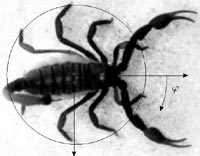brain : The time of sands
MARK HAW
 You are a moth. You have landed ten centimetres from the sand scorpion Paruroctonus mesaensis. The scorpion picks up vibrations in the sand through tiny levers on its feet. Each lever or ‘sensillum’ can detect a shift in the sand as small as one millionth of a millimetre. The scorpion knows you’re there.
You are a moth. You have landed ten centimetres from the sand scorpion Paruroctonus mesaensis. The scorpion picks up vibrations in the sand through tiny levers on its feet. Each lever or ‘sensillum’ can detect a shift in the sand as small as one millionth of a millimetre. The scorpion knows you’re there.
But its eyes are nearly useless. So how does it know which way it has to turn to come and get you? Now Leo van Hemmen and a team of theoretical physicists from the Technical University of Munich, Germany, have applied mathematics to a neural model dreamed up by zoologists in the 1970s to work out the answer.
The neural model assumes that sensory neurons are connected to the ultra-sensitive sensilla on the scorpion’s legs. Vibrations travel out in waves from the prey. When a sensillum senses the vibrations, it starts to send signals to its neuron. But the neural wiring is set up so that when, a split-second later, the vibrations reach the sensilla on the legs on the far side of the scorpion, they set off ‘inhibitory’ neurons that switch off the first signals.
So the ‘time window’ during which signals accumulate for a given neuron — which determines the probability that that neuron will ‘fire’ — depends on the time difference between vibrations reaching the sensilla of one leg and those of the legs opposite. And this time difference reflects the direction of the prey.
Given an ‘input’ prey position, the new mathematical model uses these time windows to calculate the neuron firing probabilities for each leg, and converts the sum over the eight legs into a probability for the final turning angle of the scorpion. The mathematics models how the eight legs ‘vote’ on which direction the scorpion should turn.
Van Hemmen’s group compare their calculations with experiments on sand scorpions carried out by zoologist Philip Brownell of Oregon State University. Brownell is impressed by the "very good agreement" between calculations and experiments. And the neural model ought to apply to other animals: "Nature is conservative," Brownell says.
Frank Moss of the Center for Neurodynamics, University of Missouri, thinks crayfish, which detect tiny vibrations through sensors in their tails, might work in a similar way: "There are cross-inhibitory connections similar to the scorpion," he explains.
According to van Hemmen, the new mathematical model also works for the backswimmer or water boatman Notonecta undulata, an insect that detects prey vibrations in the water surface from which it suspends itself.
Even with such simple animals there is a lot that we don’t understand. We know almost nothing about the physiology of how the ‘voting procedure’ converts sensory neuron signals into movement. And little more about how animals such as scorpions, spiders, crayfish, and even some species of frog, sense such nanoscopic vibrations.
Nevertheless, van Hemmen’s mathematical model of ‘firing probabilities’ demonstrates beautifully how an animal can use a simple neuronal structure to solve a complex problem — like where lunch is coming from.
Mark Haw is the EPSRC/Nature Media Fellow
- Sturzl, W., Kempter, R. & van Hemmen, J. L. Theory of arachnid prey localization. Physical Review Letters 84, 5668–5671 (2000).